Analysis of the(3+1)-Dimensional Fractional Kadomtsev–Petviashvili–Boussinesq Equation: Solitary, Bright, Singular, and Dark Solitons
Abstract
1. Introduction
2. Applications of Fractional Calculus
- Definition of Conformable Derivative:
- Some Properties of Conformable Derivative:
3. Formation of Proposed Methods
3.1. Extended Simple Equation Method
3.2. -Expansion Method
- CASE I: When
- CASE II: When
- CASE III: When
3.3. The -Expansion Method
3.4. Modified F-Expansion Method
4. Applications
4.1. Application of Extended Simple Equation Method
- CASE 1: ,
- FAMILY-I
- FAMILY-II
- CASE 2: ,
- CASE 3: ,
- FAMILY-I
- FAMILY-II
- FAMILY-III
4.2. The -Expansion Method
- CASE I:
- CASE II:
- CASE III:
4.3. The -Expansion Method
- CASE II: ,
- CASE III: ,
- CASE IV: ,
- CASE V:
4.4. Modified F-Expansion Method
- FAMILY-I
- FAMILY-II
- FAMILY-III
- FAMILY-I
- FAMILY-II
- FAMILY-III
- FAMILY-I
- FAMILY-II
- FAMILY-III
- FAMILY-I
- FAMILY-II
- FAMILY-III
- FAMILY-I
- FAMILY-II
- FAMILY-III
- A = B = 0
- B = C = 0
- C = 0
5. Discussion of the Results
- Our solutions and are likely similar to solutions and mentioned in Equations (3.12–3.13) respectively in [37].
- Our solutions and are likely similar to solutions and mentioned in Equations (4.4–4.5) respectively in [38].
- Our solution is likely similar to solution mentioned in [39].
6. Conclusions
Author Contributions
Funding
Data Availability Statement
Conflicts of Interest
Appendix A
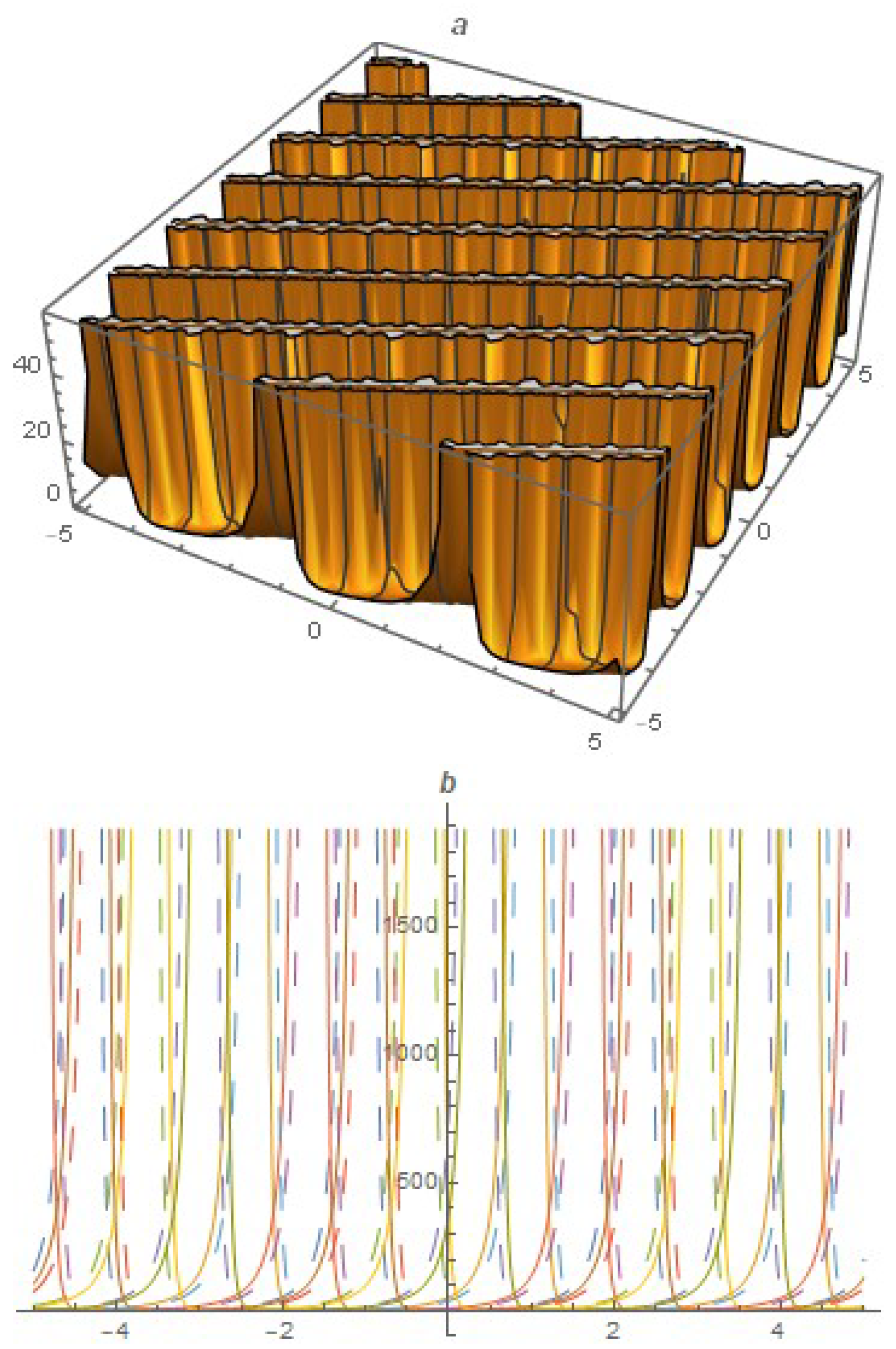
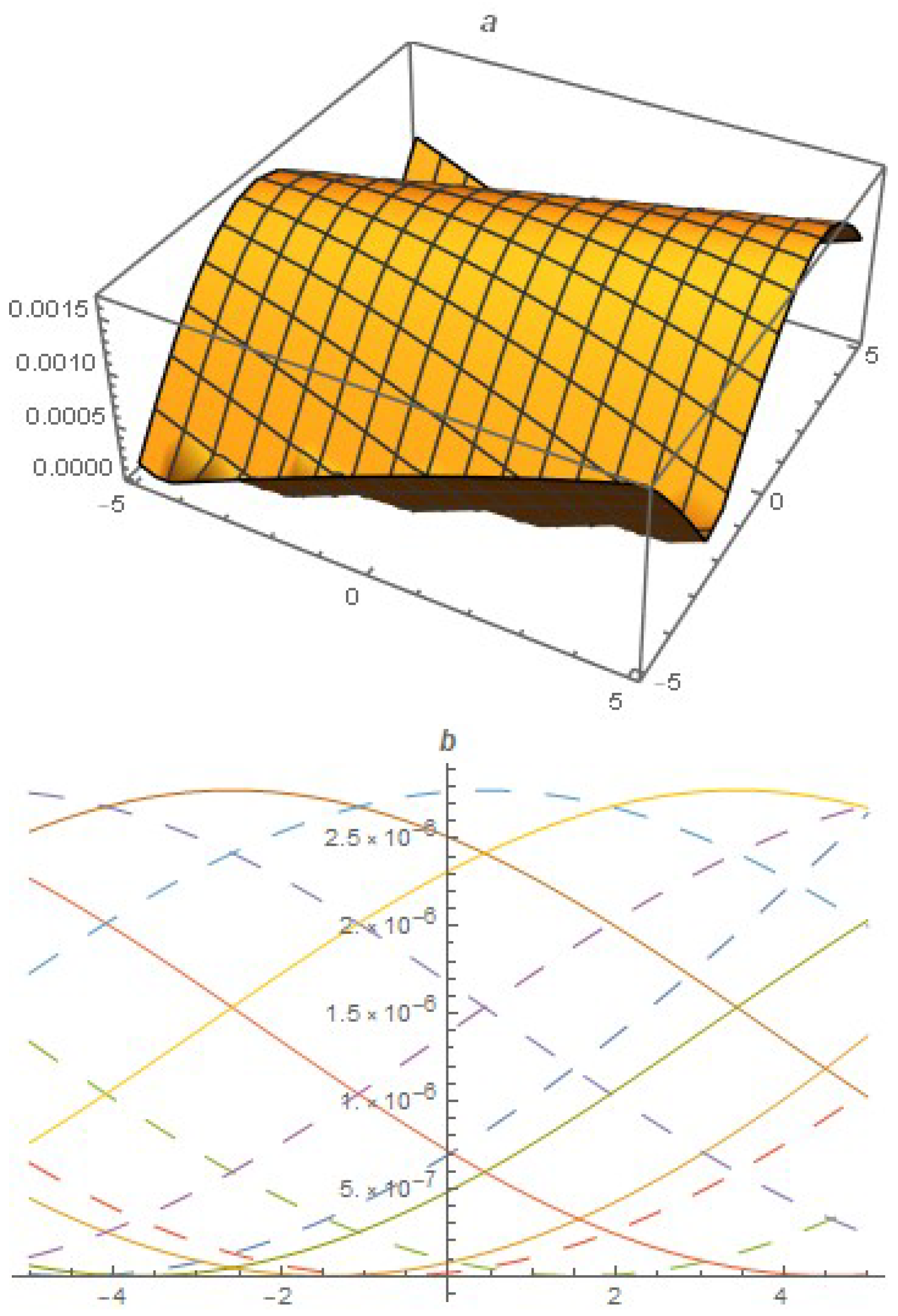
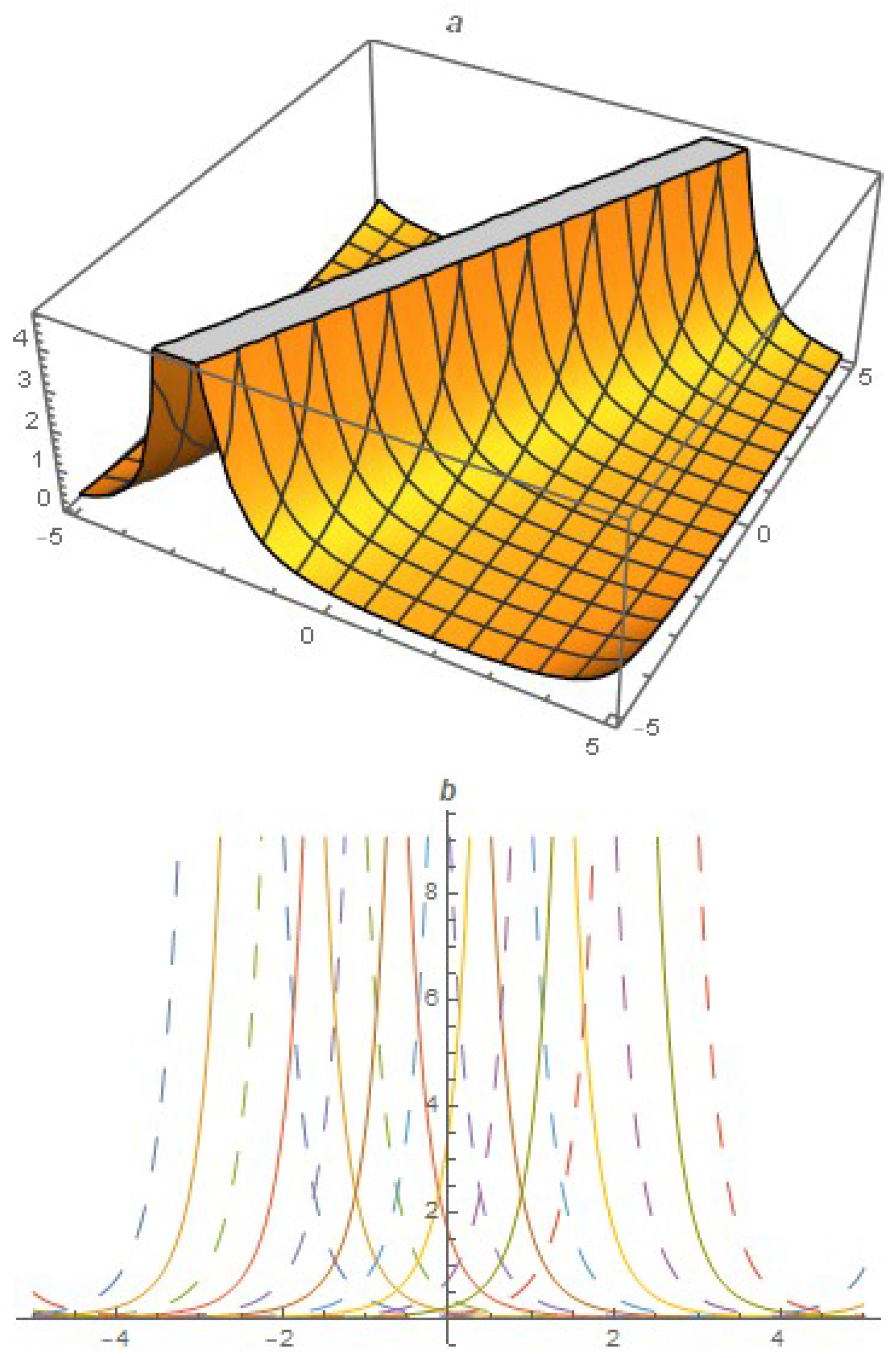
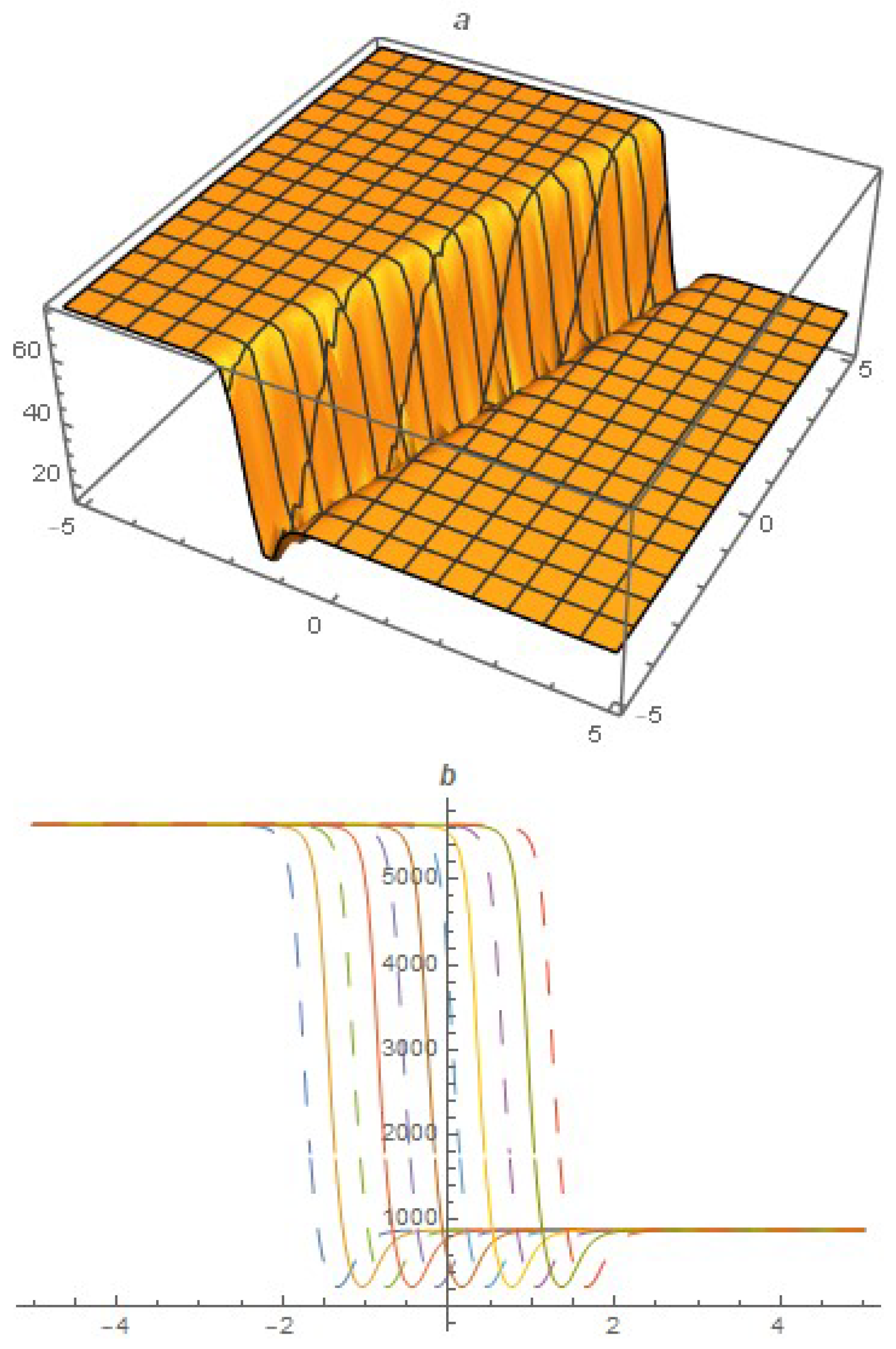
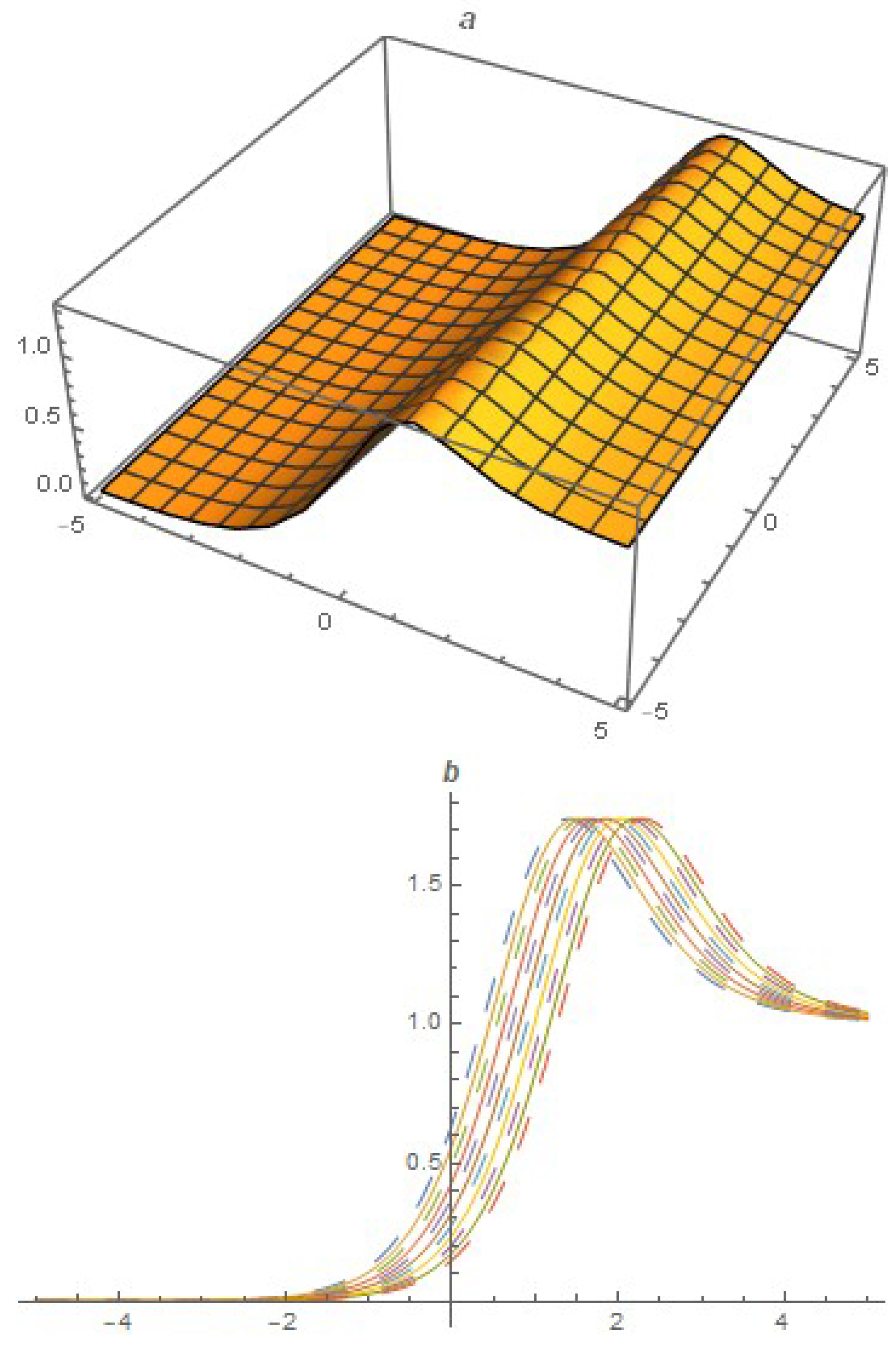
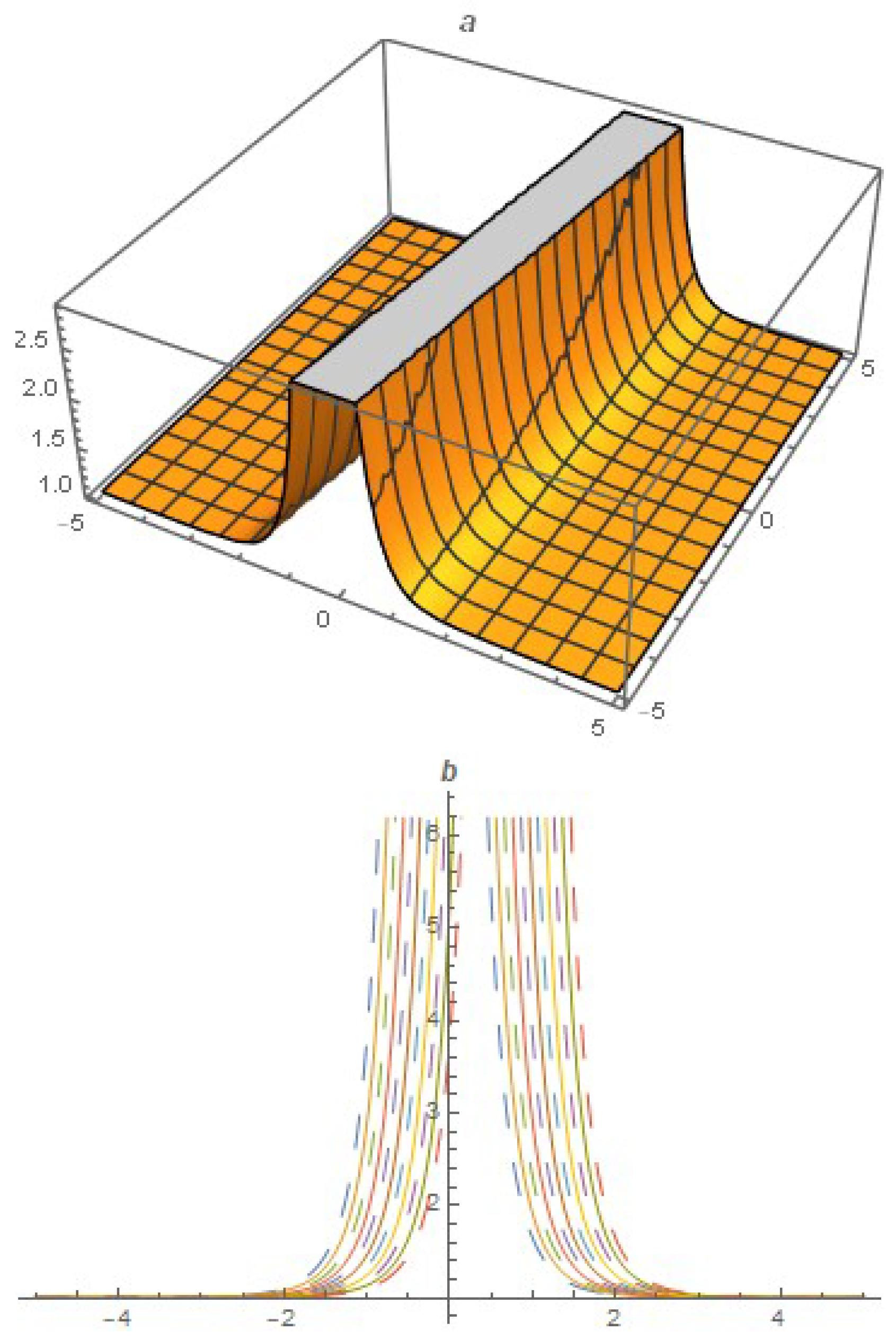
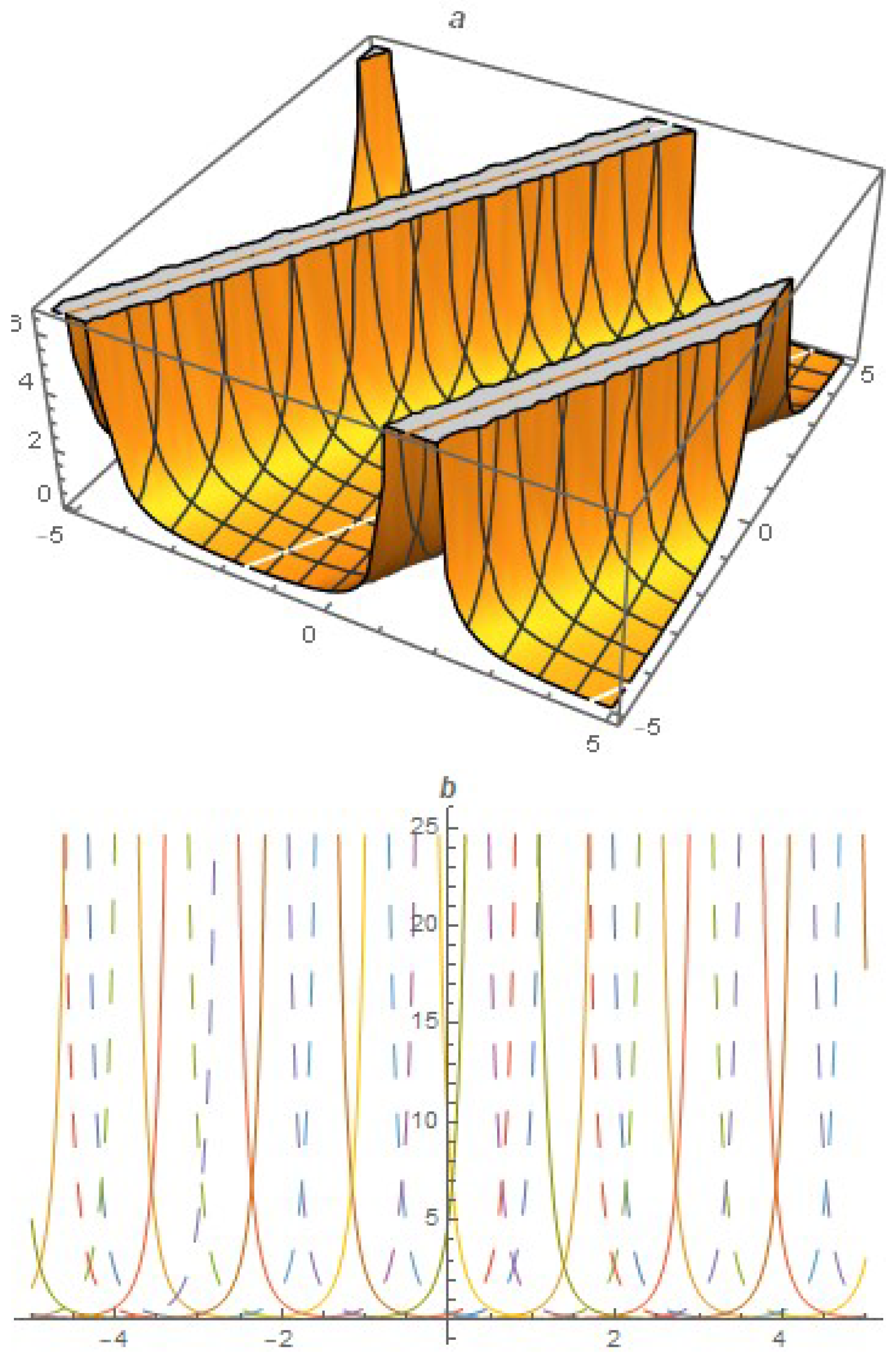
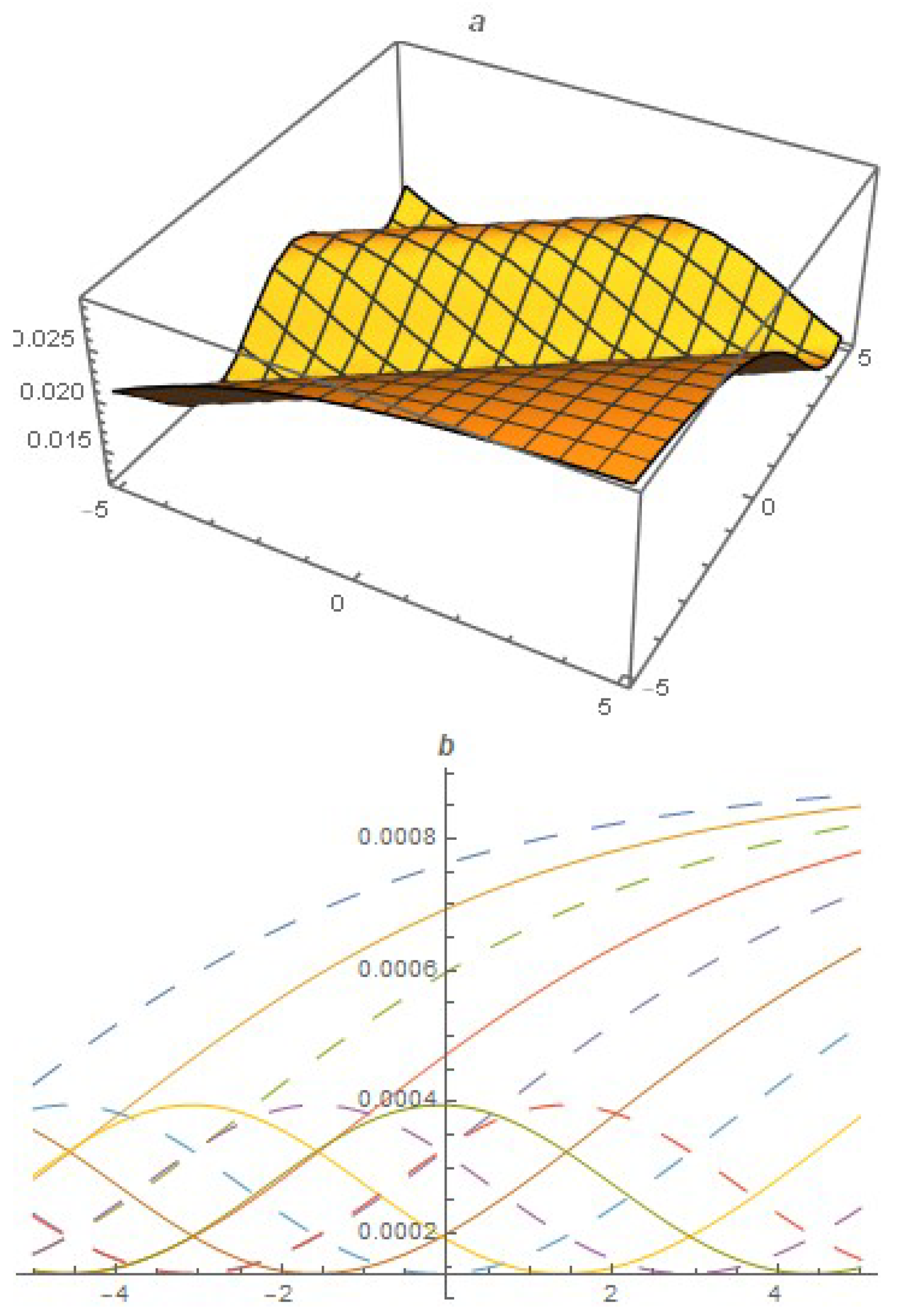
References
- Islam, M.N.; Asaduzzaman, M.; Ali, M.S. Exact wave solutions to the simplified modified Camassa-Holm equation in mathematical physics. AIMS Math. 2020, 5, 26–41. [Google Scholar] [CrossRef]
- Asaduzzaman, M.; Ali, M.Z. Existence of multiple positive solutions to the Caputo-type nonlinear fractional Differential equation with integral boundary value conditions. Fixed Point Theory 2022, 23, 127–142. [Google Scholar] [CrossRef]
- Gharami, P.P.; Gazi, M.A.; Ananna, S.N.; Ahmmed, S.F. Numerical exploration of MHD unsteady flow of THNF passing through a moving cylinder with Soret and Dufour effects. Partial. Differ. Equ. Appl. Math. 2022, 6, 100463. [Google Scholar] [CrossRef]
- Rozenman, G.G.; Shemer, L.; Arie, A. Observation of accelerating solitary wavepackets. Phys. Rev. E 2020, 101, 050201. [Google Scholar] [CrossRef] [PubMed]
- Al-Ghafri, K.S.; Krishnan, E.V.; Khan, S.; Biswas, A. Optical Bullets and Their Modulational Instability Analysis. Appl. Sci. 2022, 12, 9221. [Google Scholar] [CrossRef]
- Houwe, A.; Inc, M.; Doka, S.Y.; Akinlar, M.A.; Baleanu, D. Chirped solitons in negative index materials generated by Kerr nonlinearity. Results Phys. 2020, 17, 103097. [Google Scholar] [CrossRef]
- Kudryashov, N.A. One method for finding exact solutions of nonlinear differential equations. Commun. Nonlinear Sci. Numer. Simul. 2012, 17, 2248. [Google Scholar] [CrossRef]
- Zayed, E.M.E.; Arnous, A.H. DNA dynamics studied using the homogeneous balance method. Chin. Phys. Lett. 2012, 29, 080203. [Google Scholar] [CrossRef]
- Houwe, A.; Abbagari, S.; Salathiel, Y.; Inc, M.; Doka, S.Y.; Crapin, K.T.; Doka, S.Y. Complex traveling-wave and solitons solutions to the Klein-Gordon-Zakharov equations. Results Phys. 2020, 10, 103127. [Google Scholar] [CrossRef]
- Kudryashov, N.A.; Ryabov, P.N.; Fedyanin, T.E.; Kutukov, A.A. Evolution of pattern formation under ion bombardment of substrate. Phys.Lett. A 2013, 377, 753–759. [Google Scholar] [CrossRef]
- Abbagari, S.; Kuetche, V.K.; Bouetou, T.B.; Kofane, T.C. Traveling wave-guide channels of a new coupled integrable dispersionless system. Commun. Theor. Phys. 2012, 57, 10. [Google Scholar]
- Abbagari, S.; Youssoufa, S.; Tchokouansi, H.T.; Kuetche, V.K.; Bouetou, T.B.; Kofane, T.C. N-rotating loop-soliton solution of the coupled integrable dispersionless equation. J. Appl. Math. Phys. 2017, 5, 1370–1379. [Google Scholar] [CrossRef]
- Mukam, S.P.T.; Abbagari, S.; Kuetche, V.K.; Bouetou, T.B. Generalized Darboux transformation and parameter-dependent rogue wave solutions to a nonlinear Schrödinger system. Nonlinear Dyn. 2018, 93, 56. [Google Scholar] [CrossRef]
- Mukam, S.P.T.; Abbagari, S.; Kuetche, V.K.; Bouetou, T.B. Rogue wave dynamics in barotropic relaxing media. Pramana. Pramana J. Phys. 2018, 91, 56. [Google Scholar] [CrossRef]
- Houwe, A.; Yakada, S.; Abbagari, S.; Youssoufa, S.; Inc, M.; Doka, S.Y. Survey of third-and fourth-order dispersions including ellipticity angle in birefringent fibers on W-shaped soliton solutions and modulation instability analysis. Eur. Phys. J. Plus 2021, 136, 357. [Google Scholar] [CrossRef]
- Wang, J.; Zhang, R.; Yang, L. New metamaterial mathematical modeling of acoustic topological insulators via tunable underwater local resonance. Appl. Math. Comput. 2020, 136, 125426. [Google Scholar]
- Wang, J.; Zhang, R.; Yang, L. Solitary waves of nonlinear barotropica baroclinic coherent structures. Phys. Fluids 2020, 32, 096604. [Google Scholar] [CrossRef]
- Zhang, R.; Yang, L. Theoretical analysis of equatorial near-inertial solitary waves under complete Coriolis parameters. Acta Oceanol. Sin. 2021, 40, 54–61. [Google Scholar] [CrossRef]
- Zhang, R.; Yang, L. Nonlinear Rossby waves in zonally varying flow under generalized beta approximation. Dyn. Atmos. Oceans. 2019, 85, 16–27. [Google Scholar] [CrossRef]
- Elsayed, M.E.Z.; Reham, M.A.S.; Abdul-Ghani, A.-N. On solving the (3 + 1)-dimensional NLEQZK equation and the (3 + 1)- dimensional NLmZK equation using the extended simplest equation method. Comput. Math. Appl. 2019, 87, 3390. [Google Scholar]
- El-Taibany, W.F.; El-Labany, S.K.; Behery, E.E.; Abdelghany, A.M. Nonlinear dust acoustic waves in a self-gravitating and opposite-polarity complex plasma medium. Eur. Phys. J. Plus 2019, 134, 457. [Google Scholar] [CrossRef]
- Sabry, R.; Moslem, W.M.; Haas, F.; Seadawy, A.R. Dust acoustic solitons in plasmas with kappa-distributed electrons and/or ions. Phys. Plasmas 2008, 15, 1. [Google Scholar]
- El-Shiekh, R.M.; Al-Nowehy, A.-G. Integral methods to solve the variable coefficient nonlinear Schrödinger equation. Z. Natuforsch. 2013, 68, 255–260. [Google Scholar] [CrossRef]
- Munro, S.; Parkes, E. The derivation of a modified Zakharov-Kuznetsov equation and the stability of its solutions. J. PlasmaPhys. 1999, 62, 305–317. [Google Scholar] [CrossRef]
- Oriti, D. Approaches to Quantum Gravity; Cambridge University Press: Cambridge, UK, 2009. [Google Scholar]
- Magin, R.L. Fractional Calculus in Bioengineering. Crit. Rev. Biomed. Eng. 2004, 32, 1–104. [Google Scholar]
- Silva, M.F.; Machado, J.A.T.; Lopes, A.M. Position/forcecontrolofawalkingrobot. Mach. Intell. Robot. Control 2003, 5, 33–44. [Google Scholar]
- Malomed, B.A. Basic fractional nonlinear-wave models and solitons. Choas 2024, 34, 022102. [Google Scholar] [CrossRef]
- Fahad, A.; Boulaaras, S.M.; Rehman, H.U.; Iqbal, I.; Saleem, M.S.; Chou, D. Analysing soliton dynamics and a comparative study of fractional derivatives in the nonlinear fractional Kudryashov’s equation. Results Phys. 2023, 55, 107114. [Google Scholar] [CrossRef]
- Chu, J.; Liu, Y. Coupling model of a generalized second grade fluid flow and fractional Cattaneo heat transfer with magnetic field and radiation. Results Phys. 2024, 57, 107409. [Google Scholar] [CrossRef]
- Nikolova, E.V. Exact Travelling-Wave Solutions of the Extended Fifth-Order Korteweg-de Vries Equation via Simple Equations Method (SEsM): The Case of Two Simple Equations. Entropy 2022, 24, 1288. [Google Scholar] [CrossRef] [PubMed]
- Zheng, B. (G′/G)-Expansion Method for Solving Fractional Partial Differential Equations in the Theory of Mathematical Physics. Commun. Theor. Phys. 2012, 58, 623. [Google Scholar] [CrossRef]
- Seadawy, A.R.; Ali, A.; Helal, M.A. Analytical wave solutions of the (2+1)-dimensional Boiti-Leon-Pempinelli and Boiti-Leon-Manna-Pempinelli equations by mathematical methods. Math. Meth.Appl. Sci. 2021, 44, 14292–14315. [Google Scholar] [CrossRef]
- Wang, M.; Li, X.; Zhang, J. The (G′/G)-expansion method and travelling wave solutions of nonlinear evolution equations in mathematical physics. Phys. Lett. A 2008, 372, 417–423. [Google Scholar] [CrossRef]
- Lu, D.; Seadawy, A.R.; Ali, A. Structure of traveling wave solutions for some nonlinear models via modified mathematical method. Open Phys. 2018, 16, 854–860. [Google Scholar] [CrossRef]
- Khalil, R.; Al Horani, M.; Yousef, A.; Sababheh, M. A new definition of fractional derivative. J.Comput. Appl. Math. 2014, 264, 65–70. [Google Scholar] [CrossRef]
- Nofal, T.A. Simple equation method for nonlinear partial differential equations and its applications. J. Egypt. Math. Soc. 2016, 24, 204–209. [Google Scholar] [CrossRef]
- Akcagil, Ş.; Aydemir, T. Comparison between the (G′/G) -expansion method and the modified extended tanh method. Open Phy. 2016, 10, 1515. [Google Scholar]
- Guoliang, C.; Qingchao, W. A Modified F-expansion Method for Solving Nonlinear PDEs. J. Info. Comput. Sci. 2007, 2, 3–16. [Google Scholar]
Disclaimer/Publisher’s Note: The statements, opinions and data contained in all publications are solely those of the individual author(s) and contributor(s) and not of MDPI and/or the editor(s). MDPI and/or the editor(s) disclaim responsibility for any injury to people or property resulting from any ideas, methods, instructions or products referred to in the content. |
© 2024 by the authors. Licensee MDPI, Basel, Switzerland. This article is an open access article distributed under the terms and conditions of the Creative Commons Attribution (CC BY) license (https://creativecommons.org/licenses/by/4.0/).
Share and Cite
Seadway, A.R.; Ali, A.; Bekir, A.; Cevikel, A.C. Analysis of the(3+1)-Dimensional Fractional Kadomtsev–Petviashvili–Boussinesq Equation: Solitary, Bright, Singular, and Dark Solitons. Fractal Fract. 2024, 8, 515. https://doi.org/10.3390/fractalfract8090515
Seadway AR, Ali A, Bekir A, Cevikel AC. Analysis of the(3+1)-Dimensional Fractional Kadomtsev–Petviashvili–Boussinesq Equation: Solitary, Bright, Singular, and Dark Solitons. Fractal and Fractional. 2024; 8(9):515. https://doi.org/10.3390/fractalfract8090515
Chicago/Turabian StyleSeadway, Aly R., Asghar Ali, Ahmet Bekir, and Adem C. Cevikel. 2024. "Analysis of the(3+1)-Dimensional Fractional Kadomtsev–Petviashvili–Boussinesq Equation: Solitary, Bright, Singular, and Dark Solitons" Fractal and Fractional 8, no. 9: 515. https://doi.org/10.3390/fractalfract8090515
APA StyleSeadway, A. R., Ali, A., Bekir, A., & Cevikel, A. C. (2024). Analysis of the(3+1)-Dimensional Fractional Kadomtsev–Petviashvili–Boussinesq Equation: Solitary, Bright, Singular, and Dark Solitons. Fractal and Fractional, 8(9), 515. https://doi.org/10.3390/fractalfract8090515







